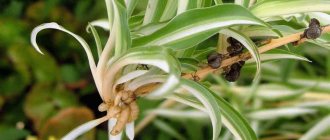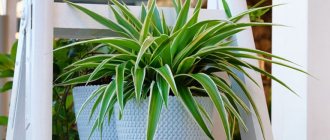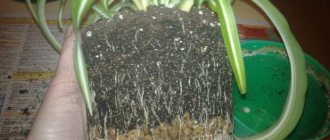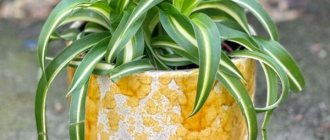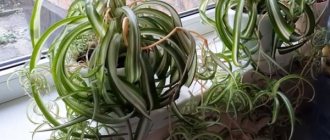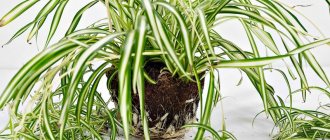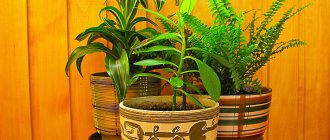What does chlorophytum curly look like, what family does it belong to?
In indoor growing, the most popular varieties of chlorophytum are:
- Curly is a compact type of bush with curled leaves that begin to curl with good care.
- Crested - has long narrow leaf blades painted bright green.
- Orange - the leaves are wider than the previous ones, have an oval shape and a dark green color.
Climbing Chlorophytum bonnie
Important! Despite the variety of species and varieties of chlorophytum, caring for these plants is identical.
Medicinal properties
The plant has a number of properties that are beneficial:
- cleans the air of dust and germs;
- absorbs any chemical compounds in the air;
- releases moisture if it receives enough of it;
- releases a lot of oxygen.
Briefly about the history of appearance
Back in 1974, the first species of this plant were described. They were discovered in South Africa. In the second half of the 19th century, the bush was brought to Europe, after which breeding work began.
Types of chlorophytum
Despite the numerous types of flowers, there are only 4 popular varieties that successfully grow in Russia:
Chlorophytum curly - has the second name Chlorophytum Bonnie. Its name already describes the appearance of the plant - its leaves are short and wide, curled and have an unusual color with stripes of dark green or white. If you care for it correctly, you can enjoy small “panicles” of light-colored blooms throughout the spring and summer.
Chlorophytum crested - has a low stem from which elongated leaves extend. This is the most common species in Russia; it can be found in almost every gardener. The plant is interesting for its growth - new leaves emerge from the axils, which gradually take the positions of the old ones. This species produces white, star-shaped flowers that grow primarily on shoots.
Orange chlorophytum - the appearance of the presented plant is so interesting that it is chosen by many experienced gardeners or beginners who prefer harmony between the interior and living plants. The flower has an orange-red petiole from which dark green leaves emerge. This species has several varieties that differ from others in the rich orange hue of their leaves. They are not so easy to care for - the color can be lost if any mistake is made. For example, if there are a large number of peduncles, the leaves turn from orange to green.
Chlorophytum capis is a rare species in Russia. It differs from the others by the presence of a tuber instead of the usual ornate roots. The leaves are also of an interesting shape - they reach 3 cm in width and about 60-70 cm in length.
All types of chlorophytum, with the exception of Cape, have daughter rosettes used for propagation. They are easily separated and rooted, which will be discussed in more detail later.
Conditions for keeping chlorophytum. Video:
Chlorophytum. Conditions for keeping Chlorophytum. Is it possible to destroy Chlorophytum?
Features of caring for chlorophytum curly at home
Chlorophytum - home care and reproduction
Many gardeners confirm that caring for chlorophyte is a pleasure. In order for the flower to grow well, develop and bloom lushly, you should not neglect agricultural technology.
Temperature
Since chlorophytum is native to South Africa, the plant does not tolerate low temperatures and drafts. The temperature should not fall below +18 ℃. In winter, it is better to place a flower pot in a heated room on a warm windowsill.
Reproduction of chlorophytum at home
Lighting
The flower loves diffused light and needs it. If the pot is placed in the shade, nothing will happen to the chlorophytum. The plant is often located in hallways, stairwells and corridors.
Watering
Tropical origin determines the need for frequent and abundant watering at high room temperatures. The soil in the pot should not dry out, but should always be kept moist.
Note! In the autumn-winter period, watering is carried out moderately.
Spraying
Chlorophytum bonnie variety curly loves high humidity. Periodically give the flower a light shower. This is especially true in situations where the pot is close to radiators.
Humidity
The flower tolerates dry air in the house normally, with the exception of the summer season. During this period, the crown must be sprayed daily with settled water.
Priming
The soil for planting a flower should be loose, well permeable, but at the same time nutritious. A mixture of soil from under coniferous (deciduous) trees, coarse sand and humus is suitable. Don’t forget about the drainage layer, which will retain moisture for a long time.
Feeding
Chlorophytum bonnie loves feeding. Fertilizers need to be applied only in summer. Ready-made formulations for indoor deciduous plants are suitable. Frequency – once every 2 weeks.
Necessary care at home
Chlorophytum cannot be called a capricious plant; on the contrary, in an apartment it behaves loyally and only due to strong changes in the usual environmental parameters can it change its usual behavior. For example, curly chlorophytum can straighten its leaves. This charming mutation will disappear if the air is too dry, watering is irregular, and nutrition is poor.
Light-loving flower
Chlorophytum feels best under bright but diffuse lighting. Direct rays can burn it, and deprive variegated forms of their bright color, which, however, can happen in too shaded places. The owners should find an area optimally removed from the sun where the flower will feel comfortable. It is worth noting that chlorophytum tolerates several hours of direct sunlight very well, so the south-east window is an ideal zone for it.
Direct sunlight is not very beneficial for the flower. They can burn the leaves or discolor them. If the plant is on a south-facing window, shade it during the midday hours.
A pale appearance indicates temperature disturbances
The temperature range that chlorophytum tolerates is very impressive. It easily tolerates the summer heat and also does well in the winter window at a temperature of 8–10 °C. Moreover, when the temperature drops below 8 ° C, chlorophytum will not die, it will simply affect its appearance of the flower, it will turn pale and begin to wither.
When and how does it bloom
Chlorophytum - species Green Orange, winged, green, Laxum
The plant blooms in the warm season. Flowers do not have decorative value. The foliage has a more attractive appearance than the inflorescences.
Types of flowers
Small white flowers are formed on short peduncles, which are completely inconspicuous in appearance.
Flowering period
Chlorophytum blooms in spring and summer. Throughout the warm season, you can observe the blooming inflorescences.
Divided plants for planting
Changes in care during the flowering period
During the flowering period, the plant expends a lot of energy and nutrients. To replenish microelements, regular fertilizing and watering are carried out. At this time, the bush begins to dry out especially quickly.
Medicinal properties
For modern people, Chlorophytum alata is invaluable; it is considered a “home ecologist.” Scientists have found that the perennial has a unique ability - it removes harmful substances from the water. It easily eliminates formaldehyde and toxins, carbon monoxide and impurities released into the environment. Medicinal characteristics of the plant:
- Destroys pathogenic microflora. One adult bush with the help of phytoncides cleans about 2 square meters. m. space from pathogenic microbes. A few perennials are enough to always have virtually sterile air in your apartment. The flower kills up to 80% of the bacteria around it.
- Relieves gas pollution. Often the flower is placed on refrigerators and near gas and electrical equipment. It is able to purify the air from harmful emissions from household appliances, aerosols and chemicals.
- Absorbs small dust particles in the air.
- Helps increase humidity. Chlorophytum accumulates moisture between the leaves and, if necessary, releases it into the atmosphere.
- Copes with mercury and lead vapors, acetone and carbon monoxide, and harmful emissions from operating factories. Even with frequently opened windows and balcony doors, there will always be clean air inside the apartment.
Important! The rapid growth of a perennial indicates severe pollution in the room. Chlorophytum Green Orange “feeds” on such substances, rather than accumulating them in the leaves
How does chlorophytum curly reproduce?
Chlorophytum curly can be propagated vegetatively and generatively.
Germination of seeds
This breeding option at home is used extremely rarely. It is mainly used by breeders in an attempt to develop new varieties. If you want to propagate a flower by seeds, you should adhere to the following scheme:
- the seeds are placed in gauze and dipped in water for germination;
- the planting substrate must contain peat and sand;
- seeds are sown on the soil surface;
- the container is covered with film and sent to a warm place;
- the crops are periodically ventilated;
- diving is done after several leaves appear on the seedlings.
Air layering
After flowering, rosettes are formed, which are used in flower propagation. To increase the chances of rooting, the cut rosette is dipped into liquid. When the roots appear, the plants are planted in a pot with soil.
Dividing the bush
The crop can be propagated by dividing the bush only after the plant reaches 3 years of age. The flower is carefully removed from the pot. The root is divided into several parts. The cuts are lubricated with crushed coal. The resulting cuttings are planted in separate containers filled with soil mixture.
Reproduction by layering
This method is much simpler, and it can be done not only in the warm season. How I do it:
- I unscrew a large rosette from an adult plant.
- I put it in a glass of water and wait for the roots to appear.
- When the root system is well developed, I make a hole in the soil.
- I'm planting a plant.
- I sprinkle it with soil, water it, and put it in a shaded place.
By the way, you can propagate a rosette with roots without cutting it off from the main flower. It is taken to a nearby pot and covered with earth. When the shoot takes root in the ground, we cut off the tendril, but I don’t touch it, the chlorophytum dries out on its own. This additional nutrition from the mother plant allows the shoot to quickly develop and take root firmly.
Possible problems in cultivation and diseases
The most common problem with this shrub is its drying out. To avoid problems, the flower is regularly watered, sprayed and ventilated.
Drops buds and leaves
The situation occurs due to a lack of nutrients and microelements in the soil. It is worth reviewing the fertilizing schedule and the fertilizer compositions used.
The leaves are turning pale
This can happen from excess moisture. Also, the flower most likely does not have enough light. Depleted soil and lack of microelements often lead to pale foliage.
The tips of the leaves are drying out
This indicates that the plant is simply drying out. The earthen ball has not been watered for a long time. Additionally, it is worth paying attention to air humidity and spraying.
The lower leaves fall off
Perhaps the soil was too flooded and the process of rotting of the root system began. In this case, moisturizing should be stopped immediately.
Pests
Among the popular pests that bother chlorophytum are aphids, thrips, and scale insects. To begin with, use a soap solution; if the solution does not help, then you will have to use chemicals.
Important! Doctors do not recommend displaying a large number of flowers in the bedroom, despite their beneficial properties.
Chlorophytum curly flower close up
Brief description of the flower
Chlorophytum curly is a fairly common specimen, often found in apartments and offices. The tropics and Africa are considered the homeland of the perennial, where it grows directly on the bark of trees. Exotic belongs to herbaceous plants, and scientists are still arguing about its relationship to a certain family: first the Liliaceae family was mentioned, then the Asparagus family.
A distinctive feature of chlorophytum is its hanging narrow leaves, on which there are peculiar tendrils that form young bushes with aerial roots. The plant's soft white flowers, resembling stars, form panicles.
Sheet plates have several color options:
- green;
- creamy green;
- white-green.
Under suitable conditions, the plant is a voluminous cascade of leaves up to 80 cm long. Chlorophytum is distinguished by a fleshy root system that accumulates a large amount of moisture. If the exotic plant is not watered for some time, it will grow and develop beautifully due to this moisture.
The perennial takes root very easily, its life expectancy is more than 10 years.
The most popular varieties
Basically, we can be pampered with crested varieties, and less often - other types of chlorophytum.
Vitatum
Variety of crested chlorophytum.
The leaves of the variety are green, but with a white stripe down the center of the leaf, running along its entire length. Moreover, this stripe can be either ideal, as if drawn under a ruler, or vague, gradually expanding.
Variegata
But this crested plant is colored exactly the opposite: the middle of its leaves is lush green, and the sides are light, even a little silver.
Ocean
It is similar to the previous variety (also green leaves with white sides), but this tufted bush has leaves arranged in a spiral. Although in fact, this is clearly visible only on a young, “skinny” plant, and only if you look closely.
Laxum
Another crested chlorophytum with green leaves edged with white. This time they grow in the shape of a fan (and this is also not very noticeable).
Maculatum
The last variety of crested chlorophytum in this list, it is also the brightest and most unusual: its longitudinal stripe (and quite wide) is colored yellow, and the leaves on the sides are green.
Green Orange
The most popular variety of winged chlorophytum.
The bush has pronounced differences in its appearance: noticeable orange petioles and dark shiny leaves. Green Orange differs from other winged chlorophytums in having longer petioles, but at the same time the compact size of the bush (30 cm).
Fire Flash
Another successful winged chlorophytum.
It differs from the previous variety in having lighter petioles.
It can also be called a sissy - for example, such a flowerpot does not like bright light, preferring partial shade, and the soil in the pot of this plant should never dry out completely (although such chlorophytum will not grow in a puddle either).
Benefits and harms
Bonnie is capable of not only decorating the interior. It has a lot of useful properties:
| Air | cleans the room air from germs and mold spores |
| Adsorption | absorbs household gases , car exhaust, harmful chemical compounds emitted by furniture and building materials |
| Increase in humidity | with proper care releases moisture into the environment |
The listed qualities make it indispensable for houses and apartments whose residents suffer from allergies, asthma, bronchitis and other lung diseases.
It is not for nothing that flower growers pay tribute to the cleansing properties of the flower.
Unlike some house plants, chlorophytum is harmless and can be grown in any room, regardless of the age of the household, be it a baby or an elderly person.
At the same time, Bonnie needs protection from pets - cats love to feast on its succulent leaves, which is why the flower loses its decorative effect and takes a long time to recover.
Doctors do not recommend keeping a large number of indoor flowers in the bedroom. It is believed that at night, when plants release carbon dioxide into the surrounding air, a person may experience a lack of oxygen.
This does not apply to chlorophytum - feel free to place the flower in any room in accordance with your aesthetic preferences and conditions suitable for growing Bonnie.
Peculiarities
Recently, one can increasingly see a relatively new variety for domestic gardeners - Bonnie (Chlorophytum comosum bonnie). Its peculiarity is the formation of a curled leaf blade.
Unlike crested, Bonnie's leaves, hanging from the pot, curl into a light spiral. The leaves of the plant have a two-color color - in the middle of the green leaf blades there is a wide white longitudinal stripe.
Unusual spiral leaves give a special charm to the flower, and in combination with the flower stalks released, Bonnie looks especially impressive.
Useful properties of chlorophytum and why it is needed in the house
Many indoor plants are both beneficial and harmful. But there are cultures to which this statement does not apply. For example, many people grow chlorophytum in their homes because it is extremely beneficial. There are many reasons to have such a plant in the house, we will list the 8 main ones.
- We can say that chlorophytum performs the function of the lungs of the home, since it has the ability to purify the air. By absorbing harmful carbon compounds, it produces oxygen.
- Green lily also reduces the content of heavy metals and their compounds, and also minimizes the harmful effects of nicotine. In addition, the described culture synthesizes phytoncides that disinfect the air.
- Chlorophytum is so diverse that you can choose a variety to suit every taste among green or variegated ones with different combinations of stripes.
- There is always a suitable place for a flower, since it can be grown both on a windowsill and as an hanging plant, suspended away from the window.
- The unpretentiousness of the plant allows it to adapt to the simplest care and tolerate dry air in apartments.
- It grows quickly and reproduces easily with the help of daughter rosettes.
- Chlorophytum is extremely rarely attacked by pests. Therefore, you won’t have to waste time fighting them.
- Excellent for hydroponic growing if you are a fan of soilless growing of indoor flowers.
Based on the above, we can conclude that chlorophytum in the interior of a home or office is not just a decorative element. This is an indispensable attribute of premises where smokers, allergy sufferers and people suffering from pulmonary ailments live or work. The spider flower not only purifies the air, but also improves its quality and even partially absorbs extraneous noise. Green bushes will cope with these tasks especially effectively if you plant them in hanging containers above the windows. Thanks to this measure, the gardener will be able to achieve two goals at the same time: both decorative and functional.




